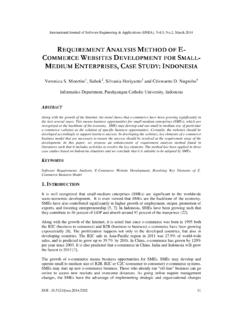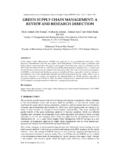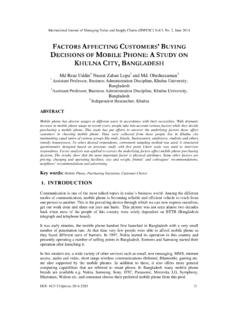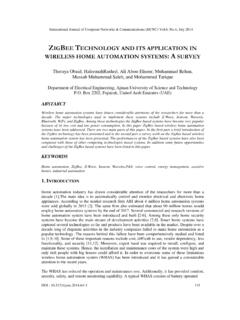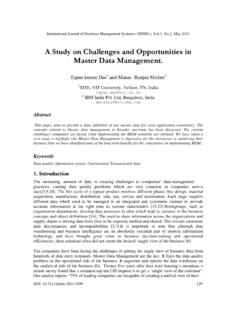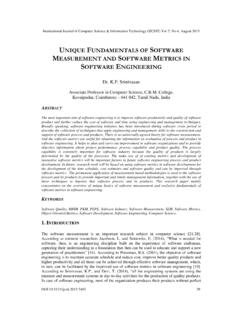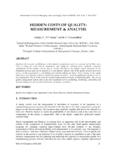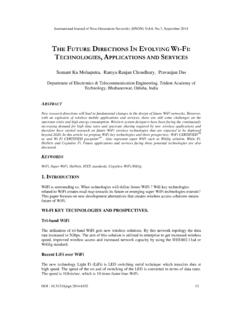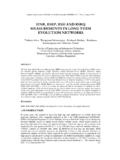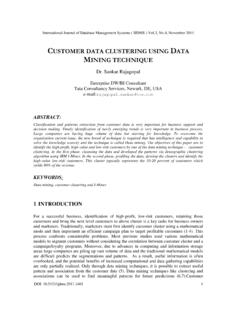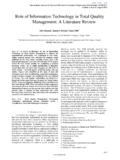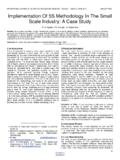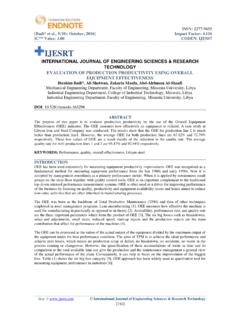Transcription of STRATEGIES TO REDUCE REWORK IN SOFTWARE …
1 International journal of SOFTWARE engineering & Applications (IJSEA), , , September 2015 DOI : 9 STRATEGIES TO REDUCE REWORK IN SOFTWARE DEVELOPMENT ON AN ORGANISATION IN MAURITIUS Vimla Devi Ramdoo1 and Geshwaree Huzooree2 1 Department of Computer Science and engineering , University of Mauritius 2 Department of IT, Charles Telfair Institute, Mauritius ABSTRACT REWORK is a known vicious circle in SOFTWARE development since it plays a central role in the generation of delays, extra costs and diverse risks introduced after SOFTWARE delivery.
2 It eventually triggers a negative impact on the quality of the SOFTWARE developed. In order to cater the REWORK issue, this paper goes in depth with the notion of REWORK in SOFTWARE development as it occurs in practice by analysing a development process on an organisation in Mauritius where REWORK is a major issue. Meticulous STRATEGIES to REDUCE REWORK are then analysed and discussed. The paper ultimately leads to the recommendation of the best strategy that is SOFTWARE configuration management to REDUCE the REWORK problem in SOFTWARE development. KEYWORDS REWORK , SOFTWARE development, SOFTWARE Quality, SOFTWARE Configuration Management 1.
3 INTRODUCTION REWORK in SOFTWARE development is the additional effort of redoing a process or activity that was incorrectly implemented in the first instance or due to changes in requirements from clients [2]. It usually results from errors, omissions, failures, changes, poor communications and poor coordination. Organisations invest in time, money and effort in order to continuously improve SOFTWARE quality in the evolving business environment [1]. REWORK directly impacts the performance and productivity and ultimately the profit margins of the firm. Therefore, it is crucial to identify and eliminate REWORK that could have been avoided.
4 One famous quote of Total Quality Management (TQM) is Do the right things, right the first time, every time implying the complete elimination of REWORK in the context of SOFTWARE development. However, literature also shows that there is some part of REWORK that is inevitable when dealing with SOFTWARE engineering . 2. RELATED WORK Boehm s (1987) research shows that REWORK costs are about 40% to 50% of all SOFTWARE development expenditures and stated that the cost of REWORK could be reduced by up to 30-50% by finding more faults earlier. According to Charette, Studies have shown that SOFTWARE specialists spend about 40 to 50 percent of their time on avoidable REWORK rather than on what they call value-added work, which is basically work that s done right the first time.
5 Once a piece of SOFTWARE makes it into the field, the cost of fixing an error can be 100 times as high as it would have been during the development stage (Charette 2005). Measuring and reducing the percentage of avoidable REWORK should be one objective of most process improvement initiatives. International journal of SOFTWARE engineering & Applications (IJSEA), , , September 2015 10 Though understood as a major SOFTWARE development activity, REWORK is often poorly defined and understood.
6 REWORK is a common problem in SOFTWARE engineering and an ongoing research area [4]. The importance of studying REWORK is highlighted in modelling projects where the REWORK cycle is at the heart of dynamic models. The principle is as follows: when development is done, it is not necessarily correct as it may contain errors that are undetected. The tasks go through testing where the errors are discovered, and eventually lead to REWORK , hence additional work to be done. This is because when REWORK increases, both elapsed time and project effort increases [16]. The REWORK cycle is actually one of the major research and application areas, especially in dynamic modelling.
7 [7]. The cost associated with REWORK remains one of the main concern in SOFTWARE development since cost is an important parameter defining the success of SOFTWARE projects [5, 20]. It is essentially the monetary cost associated to fix a work that has already been completed. REWORK is a prevailing scourge as it consumes up to 40 to 70 % of a project s budget. Project management problems such as communication and work conditions introduce REWORK in SOFTWARE projects and research shows that REWORK could be identified and avoided at an early stage. But in this era of SOFTWARE development, not much consideration has been given to studying REWORK since it is challenging and complex [6].
8 Research on REWORK has focussed on minimizing the amount of REWORK that a SOFTWARE project may acquire, through formal reviews, inspections and tests with the aim to detect and enable the correction of problems as early in the SOFTWARE life cycle as possible. Some researchers mention modelling as a technique to prevent costly REWORK through prediction and good programming practice [17] while others made use of metrics in order to understand and REDUCE SOFTWARE REWORK [18, 19]. Nevertheless, it is generally accepted that REWORK cannot be eliminated entirely, some are inevitable. However addressing this issue is of utmost importance to keep REWORK at a minimal level [8,9,10].
9 3. METHODOLOGY After reviewing relevant literature, a study was carried out in a SOFTWARE organisation in Mauritius in order to determine the root causes of REWORK in their SOFTWARE development process. Figure 1 depicts the results of the survey through the traditional Ishikawa cause and effect diagram (also known as the fish-bone diagram). International journal of SOFTWARE engineering & Applications (IJSEA), , , September 2015 11 Figure 1.
10 Root cause analysis of REWORK in SOFTWARE development The identified root causes of REWORK are as follows: Ambiguous Project Requirements Requirement issues remain a major problem in SOFTWARE development [2] as some requirements do not become apparent until the SOFTWARE exists. There were problems regarding the requirements in the production team since they were uncertain of the exact requirements of the SOFTWARE due to the following reasons: 1) Poorly defined and/or incomplete requirements, 2) Unrealistic expectations of the customers due to communication issues, 3) Conflicting requirements from different members of the production team, 4) Requirement gathering becomes difficult when key members are on leave, 5) Not all members are available at the same time and their degree of involvement differs, 6) Changes in requirements were not documented on a single repository.
